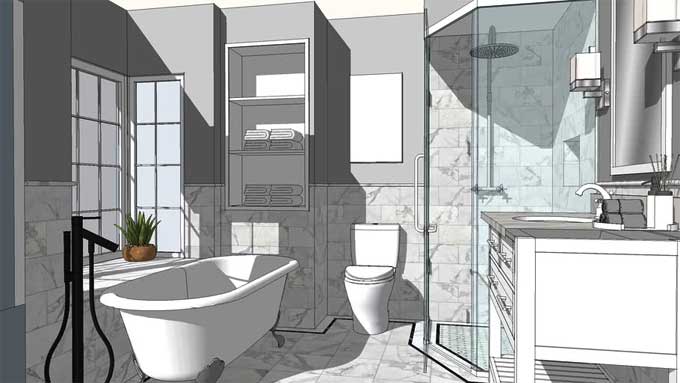Methods of designing a 3D Bathroom model using SketchUp

As fun and creative as designing your home's many rooms might be, for those without a clear vision or a cheat sheet of which way to go to achieve your goals, it can also be a very laborious and perplexing process.
Similar to kitchen design, bathroom design can be particularly challenging because, in addition to the aesthetics, such as furniture storage and fixture design selection, you also need to take care of the technical aspects, such as bathroom pipelines and water treatment, at the same time. Managing the plumber, the painter, and the flooring at the same time can naturally become overwhelming.
If done well, the bathroom can often serve as a metaphor for the style of the rest of the house, your personality, and your preferred mood while also serving as a real and metaphorical respite from the rest of the house.
We have put together a step-by-step procedure that will help you realize your idea and clarify the process of designing a bathroom if you are going to do so soon.
Step-by-step guidance on designing the bathroom using the SketchUp
Detailed Measurement
It can be said that measurements and the precise dimensions of a room are the first and most important steps when designing any space. The whole design process depends on the size of the room as well as the size of the area where the room will be placed.
When you know the bathroom's exact measurements, a lot of things become obvious from the start, giving you a good notion of what you want to accomplish and how much room you have to achieve in the final design.
While taking measurements, it will also be helpful to make rough marks on the walls for the distance between the fixtures, their height, and the area where they will be placed. This will make the layout process much simpler, as well as the product selection process for choosing the appropriate size of fixtures, sink, shower, and bathtub.
Sketching the outlines
The process of designing should begin with a list of everyone who will use the bathroom, how frequently they will use it, and their individual demands. You should also make a list of all the furniture and equipment you will need in the bathroom, such as mirrors, storage, and other fixtures.
This item directly relates to the dimensions and space available in the bathroom that you previously mentioned. Don't be afraid to replace the bath with a nicer shower area if there isn't enough room in the bathroom.
Having determined one's area of choice and assembling a list of what you want, you can locate the exact location of the toilet's pipe and determine whether it is possible to move it. As much as possible, toilet pipelines should be installed with a minimum amount of bends. However, if there are no alternatives, moving toilet pipelines is possible.
Choosing a theme and a color pattern
After deciding on a plan and the plumbing fixtures and fittings, the following step is to choose a theme and color scheme.
This frequently contributes significantly to establishing the mood in the bathroom as well as the rest of the house. There are several bathroom staples and favorites that you can always choose from, such as the monochromatic colors ranging from plain white to light grey.
White not only creates the light, pleasant, and cheerful atmosphere that bathrooms need, but it also gives off a good sense of cleanliness and sanitation while also making tiny spaces appear larger and more spacious, all of which are important for bathrooms.
The bathroom may also utilize the same color scheme as the rest of the house, which not only creates a good feeling of consistency but also appears to be highly practical for designing on a budget.
Tiles and Accessories
The choice of tiles is one of the most crucial elements of bathroom design since it directly affects how the end user experiences the space on a daily basis.
While having a beautiful bathroom is vital, it is crucial that it functions flawlessly and gives the least amount of difficulty to users.
As many bathroom mishaps occur as a consequence of poor material selection, choosing the right tile material may make or break your bathroom design. In this situation, porcelain tiles are almost always preferable to ceramic tiles since they are smoother and, in comparison, provide considerably less grip, which may be devastating when paired with a wet surface.
To learn more, watch the following video tutorial.
Video Source: Dr Clare Le Roy
Choose the Aesthetic and luxurious elements
Decorating the area once the bathroom's design is complete gives the last finishing touches.
Depending on how much space you have and how much you want to make of it, these decorating elements can range from furniture for storing bathroom products to plants that add a touch of nature and warmth to the otherwise sterile bathroom. They can also include mirrors, wall hangings, book holders, and tables next to the WCs.
Lightning elements
Bathroom lighting should often be mild and ambient; it can also be in stark contrast to the room's color scheme. Bright lights complement the warmth of the darker tones of the room's color, while bright colors go wonderfully with soft, gentle lighting.
Bathroom lighting is best installed on the ceiling with overhead lighting. Strip lighting, which may be positioned behind bathroom furniture or on the edges of the mirror to illuminate the area, can also be used to produce a visual effect. This will give the room a distinct personality at night than it does during the day.



